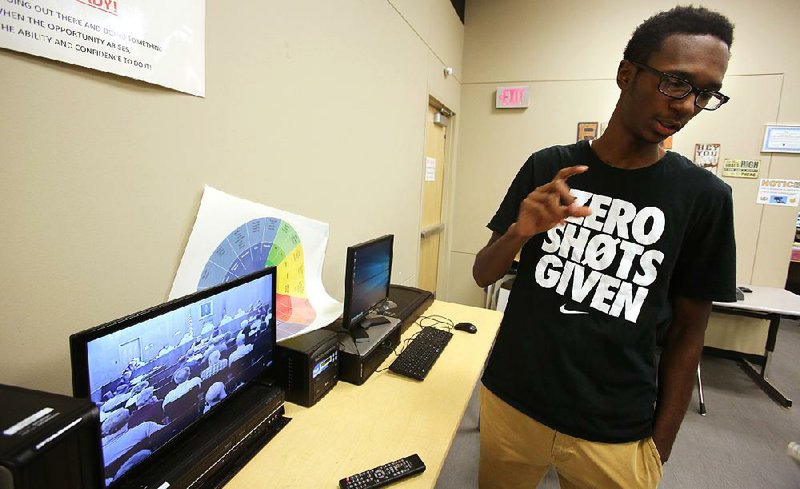North Little Rock High School senior Charles Robinson popped in a VHS videocassette tape, then turned on a DVD converter. In seconds, an Oct. 25, 2004, City Council meeting appeared on an adjacent monitor.
Inside the high school’s fifth-period Environmental and Spatial Initiative (EAST) class, there’s a box of roughly 75 completed DVDs, each containing about two hours of council meeting recordings converted from VHS tapes from as far back as the early 1990s. Another, larger box holds about 200 VHS tapes awaiting the same treatment.
The high school’s EAST Initiative, where students use technology to solve community problems, is working on the VHS conversions to help the city preserve its government history. The process includes not only converting the tapes to DVDs, but then uploading each recording onto a computer software program to allow the meeting recordings to be watched online on the North Little Rock City YouTube channel.
Mayor Joe Smith’s office recently contributed $1,000 to the high school’s EAST Initiative for its assistance in converting the old meeting recordings, a bargain to the city, North Little Rock Communications Director Nathan Hamilton said. The city stopped using VHS to record its council and Planning Commission meetings at least two years ago, he said.
“It could cost up to $50,000 to have this professionally done,” Hamilton said of converting the old tapes. “We basically give them a contribution because they are doing this service for us. They get practice doing it. They do it on their own time and at their own pace.”
This is the second year for the project, said Stan Whisnant, facilitator for the EAST Initiative. And like with other projects, he lets the students work through a process on their own. For his class, students use their own initiative and creativity to complete projects that can range from computer coding programs to 3D printing, he said.
Whisnant will suggest to a student or students a project he wants done, and the youths figure out how to make it happen, he said.
“EAST is about them learning to process a project through trial and error,” Whisnant said. “EAST gives them a risk-free way to do projects. I don’t grade them on their projects. They have to figure out why something is not right and go back and fix it. That’s learning. That’s engagement.”
Jim Billings, director of special projects for the city, approached Whisnant about whether his class could do the conversions.
“They pick up 50 to 60 at a time and work through them,” Billings said. “Then I ready them for our YouTube channel and write a description and put the date on them. That way someone can search for them in the same way.”
To convert the city’s recordings, Whisnant purchased a Toshiba VHS-DVD converter and asked which student would do the work, he said.
“He volunteered,” Whisnant said of Robinson, who started with it as a junior last year. “I don’t make them do it. And he figured it [the process] out himself.”
For Robinson, who said he wants to major in business in college and someday start his own business, he sees his project as a way of contributing to the community.
“It’s a different way to help the city,” Robinson said during a class last week. “It’s a little thing to do to help the city. Just giving something back to the community.”
Converting the VHS tapes to DVD, Whisnant said, is a “minute-by-minute” process.
“If it’s two hours worth of tape, it takes two hours to complete,” he said. Fortunately, he added, “You just get it going and leave it.
“Charles comes in at 12:05 for fifth period,” Whisnant said. “Sometimes he’ll come in before school and set one up. Once it’s set up and running, it does its thing. Then it’s ready when he comes in to fifth period. He’ll put one in and go on to something else.”
After setting one up, Robinson said he uses the time he doesn’t have to spend monitoring the recordings to label the converted disks.
“When I finalize one, I take it to Mr. Whisnant to put into the computer so it can be transferred to the digital software so they [city officials] can upload it to their website,” Robinson said. “I can also put it onto the digital software.”
Whisnant said he will store all of the disks in his classroom along with the videotapes so the city still has a “hard copy” of each recording.
Robinson said using VHS tapes isn’t that unusual even though VHS recorders haven’t been commonly used in homes for most of his life.
“My mom had VHS tapes,” Robinson said. “I used to watch old VHS tapes of me and my sister from Christmas and other holidays.
“When I first started this [project], I was watching some of the meetings,” he said. Because of the recordings’ lengths, he added: “I can’t watch the whole thing, so I would watch just snippets.”
The hardest part with any project, Whisnant said, is that the students do all the work. For the city’s project, someone else will have to take over when Robinson graduates in May.
“We have two, three, four more years of this,” Whisnant said. “I think there are 200 to 300 tapes to go that Jim has at City Hall.
“They’ve overwhelmed me at times,” he said of the amount of tapes he sometimes receives at one time. “I don’t know how far back they go. When they give them to us, we’ll do them.”
